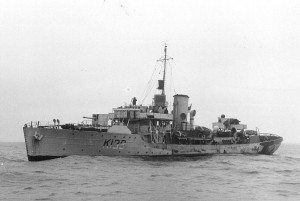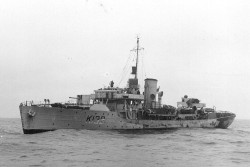 During interwar periods in different countries similar ships were called sloops, gunboats, or avisos. At the outbreak of WWII, the name corvette was revived by the British Royal Navy for a class designed to meet a pressing need for cheap and mass produced ASW escorts. As a result, a design based on a whale catcher became probably the most famous corvette type, the Flower class, the hero of Nicholas Monserrat’s novel Cruel Sea.
During interwar periods in different countries similar ships were called sloops, gunboats, or avisos. At the outbreak of WWII, the name corvette was revived by the British Royal Navy for a class designed to meet a pressing need for cheap and mass produced ASW escorts. As a result, a design based on a whale catcher became probably the most famous corvette type, the Flower class, the hero of Nicholas Monserrat’s novel Cruel Sea.“The ship envisaged was too expensive to be expendable, and yet was unable to defend itself. The whole concept was therefore philosophically “unstable,” and had to shrink to a cost level at which its loss could be accepted, or grow to a cost of over 100 million pounds in order to allow for some defensive armament.”
It seems that corvettes as opposed to OPV are dangerously close to above mentioned “unstable” zone. corvettes and other “flotilla” ships also suffer from attitudes driven by axioms of modern management. In peacetime, with only limited means available, we prioritize goals and focus on the seemingly more important “battle-force” rather than the “flotilla.” The latter falls into the “would be nice to have” category, but this changes in wartime. Vincent P. O’Hara, W. David Dickson, and Richard Worth in their book On Seas Contested illustrate wartime construction efforts during WWII made by major players by showing the number of ships built during the war, by category. This data, supplemented by a simple web search, and presented in a slightly different form makes visible how small combatants grow in number.
Why do corvettes exists at all? It seems appropriate to ask such a question if the whole class definition is based on size only. An attempt to make a generalization could be a statement that for the big navies of naval powers, corvettes fulfill some niche, specialized roles like coastal ASW, patrolling or even mine warfare, while for small navies or land powers they tend to be a capital ship. For a big navy they promise relatively low costs and hi numbers of hulls. Strict control of specifications and requirements as well as resigning from everything not related to the planned main function of the ship are essential to keep their costs within the budget. On an opposite side of spectrum, a small navy would be driven by the desire to install more powerful sensors and armament. Seakeeping and endurance could be of interest as well. The problem is that any efforts to turn these small combatants into multi-mission ships pushes them towards “unstable” zone of design.
The weakest point of corvettes seems to be their air-defense capabilit,y limited typically to self-defense. This means that at least in theory corvettes are rather easy to destroy by cruise missiles or even direct munitions dropped by aircraft. To overcome this limitation corvettes need to operate under the cover of battle-force or shore based defensive systems. They could also use tactics known from the Cold War’s “Outer Air Battle”, aiming to kill the shooter, not the arrow. Cruise missiles give corvettes disproportionate power to their size, but to use such weapons effectively, information superiority is a necessary and the best defense. Another problem that quickly emerges is the number of munitions at their disposal and how effective they are. Helicopters and/or armed UAVs are valuable assets for corvettes adding both to firepower and information superiority. Yet another road is to seek support from technology. One good example is the Swedish Visby corvette designed with the motto Invisible, not Invincible, another is the CAMM missile, which offers mid-course guidance independently from radar thus promising local area air defense for ships smaller than frigate. Or as already mentioned unmanned vehicles are another way technology can provide an edge.
The variety of tasks or functions flotilla ships like corvettes can fulfill is very large and quite often not anticipated before as shown by below excerpt from Wikipedia description of the Royal Australian Navy’s HMAS Bathurst:
“The two main purposes the ships were intended for were minesweeping and anti-submarine escort. However, the corvettes found themselves performing a wide range of duties, including troop and supply transport, bombardment, assault landings support, survey and hydrography mapping, and providing aid to disabled ships.”
So what to do with a ship so broadly defined, surprisingly useful in wartime, and in permanent tension between value and performance? If we take a look once more again on Sir Julian Corbett typical forms of naval warfare…
“For clearness we may summarize the whole in tabulated analysis, thus:
1. Methods of securing command:
(a) By obtaining a decision.
(b) By blockade.
2. Methods of disputing command:
(a) Principle of “the fleet in being.”
(b) Minor counter-attacks.
3. Methods of exercising command:
(a) Defence against invasion.
(b) Attack and defence of commerce.
(c) Attack, defence, and support of military expeditions.”
Corvettes can participate in all of these. It just depends on few factors like whether the navy possesses preponderance over the enemy, or is acting independently or as a part of coalition forces. A small navy facing a dominating enemy can still conduct minor counterattacks, but under the cover of an allied battle-force it can switch to attacking or defense of commerce or a blockade. Even decisive battle is conceivable if the enemy fleet is an equally small peer navy. Although not really a homogenous class of ships, corvettes and similar small ships will most probably continue to be popular and in demand and will surprise us by their versatility.
Przemek Krajewski alias Viribus Unitis is a blogger In Poland. His area of interest is the context, purpose, and structure of navies – and promoting discussion on these subjects in his country.


Good post Viribus, but I think the corvette’s weakest point is actually well defined in Craig Hooper’s recent post,
http://nextnavy.com/seafighters-will-never-operate-in-a-logistics-free-world/
Logistics is their largest headache. How do you operate these ships around the globe, potentially far away from bases, for long periods of time. Once you factor in either foreign basing, tenders or motherships into their overall cost structure, corvettes look less appealing.
I apologise for answering directly. Here is the right place to do it, so I would like to repeat my answer. Your comment is a good point and one often missing in discussions about real life. There is a difference between US Navy point of view which requires forward deployed forces and other navies, more coastal in nature. They have this logistical support anyway. Forward deployment is just one of possible roles and functions for corvette in US Navy. What strikes me is that I never found argument saying that because of its speed, LCS is THE only ship in US inventory able to escort JHSV. And loaded with battalion of Marines it surely deserves a screen. If forward basing is a choice, then building logistical chain is necessary and similiar to effort undertaken before WWII to support Pacific campaign (including modular floating docks). In fact something like that is already happening – AFSB joins the Navy. So maybe the right idea would be to center LCS around AFSB performing at the same time protection function?